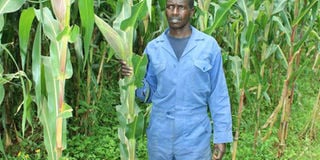My simple foliar feed from wild aloe vera

Nehemiah Koech, a farmer at Mutwet in Chesumei on his farm. PHOTO| STANLEY KIMUGE |NATION MEDIA GROUP
What you need to know:
- After coming up with the fertiliser, he took a sample to Kenya Agricultural and Livestock Research Organisation in Kakamega and at the Kitale-based Kephis for testing.
- Two-and-a-half litres of the foliar is mixed with 20 litres of water for a single spray that covers an acre.
Kap’ngetich is a little known village in Mosop, Nandi County, with many residents engaging in subsistence farming.
Mark Kipchumba is one of those growing maize, beans and vegetables, but he is doing more.
We find him busy adjusting a machine fixed on a wooden table in his homestead. Next to it is a bucket. He spent Sh1,200 to purchase the machine, a meat mincer, before he later turned it into a cold presser which he uses to make a foliar feed from wild plants, mainly aloe vera.
He picks the plants from the field, then squeezes them using the cold pressing machine and puts in a fermentation container together with orange or lemon peelings where they stay for week. The lemon or orange peels help to eradicate odour from the fermenting aloe vera. After a week, he sieves and places it in bottles.
“I started making the foliar fertiliser in 2009 after I could not afford the inorganic ones. So I decided to formulate my own fertiliser,” recounts Kipchumba, noting he started the process out of curiosity.
His desire to know more took him to Masinde Muliro University library where he learnt alot about aloe vera.
After coming up with the fertiliser, he took a sample to Kenya Agricultural and Livestock Research Organisation in Kakamega and at the Kitale-based Kephis for testing.
The results showed his foliar had several minerals required by plants. The copy from Kephis indicates that the fertiliser has Nitrogen (7.72), phosphorous (0.11), potassium (0.15), Calcium (0.05), Manganese (498.51), Iron (831.92), Zinc (454.51), Copper (1132.79), Magnesium (0.001) and a pH of (10.19).
He uses half a kilo of aloe vera plants to produce five litres of the foliar.
Two-and-a-half litres of the foliar is mixed with 20 litres of water for a single spray that covers an acre.
So far, he says about 50 farmers mostly in his neighbourhood have been able to use the bio-fertiliser.
“I sell a litre at Sh200 which is cheaper compared to the inorganic products,” he says.
Nehemiah Koech, a farmer at Mutwet in Chesumei, who has used the foliar feed, says at first he was a little sceptical
“I applied some of it on my calliandra fodder and saw good improvement in terms of foliage. I then sprayed it on my maize.”
The farmer says he first planted the maize using NPK23:23 fertiliser but didn’t top dress with CAN, instead he applied the foliar feed dubbed Auto-booster.
Normally, Koech harvests some 20 bags per acre from his farm but this time round he harvested over 30.
Pauline Koiser, a crop officer in Uasin Gishu County, says aloe vera plant is medicinal and contains unique properties that protects crops from fungal attack.
Additional reporting by Brenda Gamonde





